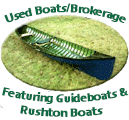 |
 Traditional Guideboat Repair & Reconstruction |
 |
 Traditional Guideboat Repair & Reconstruction |
The name Adirondack Goodboat is, of course, a sort of joke. I was offering, I thought, a kind of Volkswagen, Everyman's rowing boat to a region mystified by its old indigenous rowing boat, the Adirondack guide-boat which, in 1986 when I started making the goodboat, was little seen on the actual waters, and when there was but a sparse scattering of Adirondackers who actually knew what one was. I don't suppose anything like a majority knows now.
But this wasn't to say I didn't admire the guide-boats. I do, and much of my boat-work is to save guide-boats from going to ruin; to putting hundred-year-old ones in condition to survive another couple of decades at least and maybe much more.
This one, a Parsons, which is to say one of the very best, required many new and splined frames but most of all and entirely new bottom-bottom board and planking, with very choice pine and the famous Grant-lap. I was able to go to the Adirondack Museum and copy the planking pattern-the locations of all the scarf joints in the planking-from a mint original in storage there.
I often bleach these bright-finished guideboats when I get them stripped,
to remove stains and mildew, and then treat the wood while still soaking wet from the rinsing with sodium borate, letting the crystals follow the water deep into the wood and seams, where it kills present and, if it doesn't get leached out, future rot spores. I aim to seal those crystals in with penetrating finish (Deks Olje or linseed oil), then varnish or paint with the best finishes, usually Epifanes.
Ever since the guides' customers started ordering guideboats for themselves, the guides' black paint has given way to yachty varnish. But I like a painted boat just as well and it's even a bit more truly traditional.
The straps (as oarlock sockets are called on guideboats) are sent to the Springfield Fan Centerboard company to be re-bushed. Caning is done by Pauline Villeneuve in Tupper Lake. I make new kickplates of .020" brass, just like the originals.
I have said for years that it is not advisable to buy an old guideboat or canoe and have it restored by somebody like me if you hope to sell it for a profit. These restorations have been known to cost as much as a new guide-boat (mine have ranged from $3000 to $11000, with most around $5000 or $6000, while new boats cost $10,000 to $13,000). Buy one for a song if you can and sell it at an antique show. Let the serious keeper and user bring it to me.
What about strip-built and fiberglass or kevlar guideboats? No problem as long as they are what you want. But again, don't be deceived that you are getting a traditional Adirondack guideboat unless it is planked with 7 or so planks a side, the bevelled seams fastened with copper tacks, on frames sawn from natural spruce or tamarack roots.
If you order a traditional guideboat you have some choice among the great old designs, completely uncompromised, and your boat will probably appreciate over the years.But know this: they are infinitely restorable. And this too: that they ought not to be touched by anybody who doesn't have the skill or the eye to do them justice. Do not look at the ads, the sign, or even the shop of the workman; look at the work.